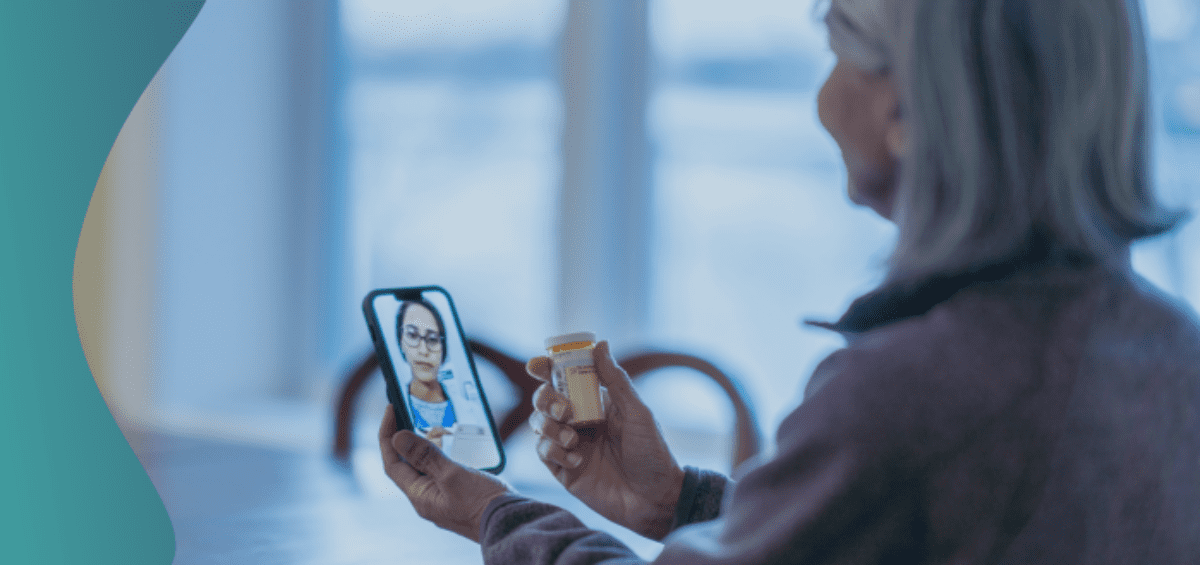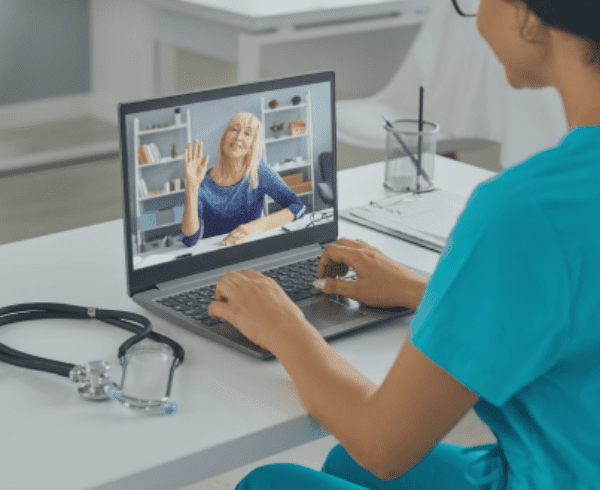October 1, 2021
When COVID-19 closures forced millions of U.S. providers to move their medical, dental, and behavioral health care services online, those working in underinvested communities had to adapt quickly—in many cases, rolling out virtual care for the very first time to patients without reliable digital access.
“In crisis, you have to adapt, and when the dust settles, it’s going to change medicine, including what we can offer our patients moving forward,” said Dr. Jorge Rubal, a family medicine physician and CEO of the Laguna Beach Community Clinic in California. This nonprofit clinic provides comprehensive primary care for many people in the area who lack health insurance, or who are experiencing poverty or housing insecurity.
Since their rapid transition to telehealth in 2020, health centers and other community-based providers across the country have been working hard to close remaining virtual care gaps, partnering with OCHIN’s HCCN to optimize newly available telehealth tools for patients who face other systemic barriers, besides limited connectivity.
Investing to Help Bridge Health Care’s Digital Divide
Since 2016, the Pew Research Center reports that rural broadband connectivity has increased by 9%, demonstrating positive progress in the ongoing effort to close America’s digital divide by expanding reliable internet access for underserved communities. Still, roughly a quarter of adults in the U.S. do not have broadband internet service at home and 27% of adults from households earning less than $30,000 a year rely solely on their smart phones to stay connected.
The technology gap is widest for rural residents and communities of color. While there are persistent geographic disparities in household connectivity, computer ownership and home broadband adoption also vary by race and ethnicity, with Black and Hispanic/Latinx people relying more heavily on mobile devices for internet connectivity. Additional research also shows that communities of color, older adults, and people with lower levels of income or formal education are most likely to experience limited digital access.
“These technological barriers exacerbate health inequity,” said Jennifer Stoll, Executive Vice President of Government Relations and Public Affairs at OCHIN, “preventing many people from experiencing the full benefits of telemedicine and limiting their opportunities for online education, employment, and social connectedness—all of which are known to affect a person’s overall health and well-being.”
Congressional efforts to advance a landmark infrastructure bill (H.R. 227 – Build America Act) would help reduce digital and health disparities by enhancing broadband connectivity for millions of people in underinvested rural and urban communities. Additionally, the Federal Communications Commission (FCC) Telehealth Program has awarded millions of dollars to expand access to telehealth services, including $3 million of support that has been disseminated through OCHIN to community-based health care organizations across our nationwide network.
These are crucial investments toward closing the digital divide in health care. But our network’s experience shows that access to technology is just the first step to providing inclusive virtual care solutions that drive health equity, rather than exacerbating health disparities.
OCHIN’s HCCN: Supporting the Telehealth Transition in Health Centers Nationwide
Operating as the largest Health Center Controlled Network (HCCN) in the country, OCHIN’s HCCN serves more than 2.2 million patients through nearly 100 participating health centers across a dozen states. With support from the Health Resources and Services Administration (HRSA) of the U.S. Department of Health and Human Services (HHS) it provides a wide range of consulting services and peer-to-peer learning opportunities to accelerate clinical quality improvement efforts by optimizing technology and workflows to improve care delivery and patient health outcomes. As a result of its size and reach among underserved communities, the OCHIN HCCN is uniquely equipped to deploy and evaluate the impact of new technology—such as the rapid transition to telehealth that occurred as a result of COVID-19 closures.
In the early months of 2020, OCHIN HCCN participating health centers swiftly adopted digital tools to support continuous patient care, with over 80 percent of sites utilizing MyChart Virtual Visits. Across the wider OCHIN network (which reaches an estimated 6 million patients nationally), telehealth utilization for patient visits that were recorded in OCHIN Epic grew from practically zero percent at the start of 2020 to an average of more than 37 percent. This year, more than 27 percent of all patient visits in the OCHIN network continue to be conducted virtually, including a large proportion of behavioral health encounters. In addition, other tools that enable automated texting, remote patient monitoring, eConsults, and E-Visits remain in high demand for the speed and efficacy they offer to providers who are overburdened by the pandemic.
Throughout COVID-19, OCHIN’s HCCN has provided ongoing technical assistance to help participating health centers deploy these new telehealth tools and workflows effectively, ensuring they stayed open and connected to patients by increasing the adoption rate of virtual tools like MyChart. For example, through a combination of technical assistance and a customized rebrand to improve patients’ online experience, the Laguna Beach Community Clinic was able to scale its MyChart usage in response to COVID-19 from a monthly average of less than 28 percent of patients using its patient portal before the pandemic to more than 41 percent in February 2021—all with support from OCHIN’s HCCN.
“The public health emergency shifted priorities for our health centers,” said Lindsey Haase, Director of HRSA and FCC Broadband Programs at OCHIN. “It has been rewarding to find ways to best utilize the OCHIN HCCN to meet the specific needs of each participating health center through tailored, collaborative support that is making a real difference in their communities of service.”
Standardized social determinants of health (SDOH) screening data is also helping OCHIN understand the full impact of telehealth on underserved communities by better illustrating who is using telehealth and who is being left behind. A recent analysis of OCHIN Epic patients in California found that patients who reported needing transportation support were 17 percent more likely to use telehealth than those who did not screen positive for transportation needs. Additionally, patients who stated they need housing support were 14 percent more likely to use telehealth than those who did not screen positive for housing needs.
While these data show the potential for telehealth to overcome structural barriers and bridge a path to health equity for some underserved communities, other inequities remain. For example, a 2020 evaluation of telehealth utilization among patients attending OCHIN Epic clinics found:
In order for virtual care tools to be effective, they must do more than connect devices—they must connect people. That means, improving connectivity for patients and providers alone is not sufficient to ensure that everyone will benefit equally from the latest advances in telemedicine.
Optimizing Virtual Care to Meet the Diverse Needs of Systemically Underserved Communities
Over the past year, OCHIN’s HCCN has gained valuable knowledge and insight into the additional systemic challenges that health centers must work with their patients to overcome, in order to deliver effective virtual care.
For example, another recent evaluation of OCHIN’s HCCN revealed three common challenges that health centers experience when attempting to connect with their patients online:
1) Patient technical issues—including issues beyond access to reliable devices or internet connectivity, such as digital inexperience and difficulty navigating the complexity of the tools and interfaces required to conduct a virtual appointment;
2) Patient language barriers—including unreliable access to online interpreters or translation services to support virtual care delivery in a patients’ preferred language, as well as informational resources and online application interfaces that patients can access in multiple languages;
3) Patient apprehension—including not feeling comfortable using high speed internet, registering for virtual tools (like MyChart), or not trusting that their personal information will remain private.
Based on these findings, OCHIN’s HCCN has developed a number of recommendations that it will use to help health centers, and other community-based providers, offer more culturally and linguistically appropriate virtual care.
For example, OCHIN’s HCCN will work to provide materials in various languages, since this was the most common non-technological challenge cited. Participating health centers can also expect to receive support, information, and workflows focused on educating patients about the value of virtual care and how to use it safely and easily, in order to reduce apprehension. This can be combined with a patient technological capabilities assessment, which will enable health centers to tailor each patients’ virtual care experience in a way that builds digital access, confidence, and engagement.
These are just a handful of the solutions and best practices the OCHIN HCCN will assist participating health centers to implement, as it enters the third year of its current grant cycle and looks to the future. Additionally, the collaborative nature of OCHIN’s HCCN allows participating health centers to benefit directly from each other’s experience, expediting knowledge sharing and scaling practical solutions. While there is still much more work to be done, OCHIN’s HCCN is dedicated to providing the ongoing tools, education, and expertise needed to expand and optimize telehealth in a way that drives national health equity.
To learn more about how OCHIN’s HCCN can support telehealth or clinical quality improvement at your organization, please visit our website: https://ochin.org/hccn.
To learn more about OCHIN’s ongoing advocacy efforts to support telehealth expansion and close the digital divide, please visit our policy page: https://ochin.org/policy.













